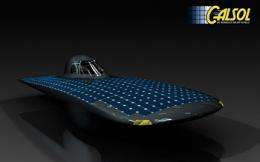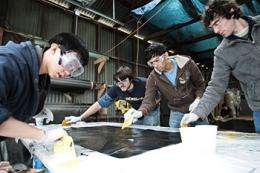Sun-driven and Australia-bound

To build a car powered completely by the sun, a team of Berkeley students is burning lots of midnight oil.
A year-and-a-half in the making, a sleek vehicle called Impulse was unveiled at Cal Day and is on track to compete in the world’s premier solar car race this October. Behind the effort is the 73-member crew of CalSol, the campus’s student-run solar vehicle team. Displaying a startup-worthy work ethic, CalSol members have devoted thousands of hours—including long evenings and some all-nighters—to the car’s design and fabrication. This fall, 15 to 20 students will withdraw from school for the semester to participate in CalSol’s first-ever entry in the World Solar Challenge, an 1,800-mile road race across Australia.
“We’re making a car, driving it across a continent and powering it with the sun,” says Chris Cartland, a third-year electrical engineering and computer sciences (EECS) student who leads CalSol. “It’s the coolest thing I can imagine doing as an undergraduate at Cal.”
Impulse, which began as a computer-generated concept, is becoming a road-hugging reality at the team’s Richmond Field Station work site.

Equipped with sophisticated electronics and six square meters of solar cells, Impulse resembles a three-wheeled spaceship. Its 16-foot-long shell is made of carbon fiber, honeycomb material and other strong but lightweight composites. To conserve energy, Impulse is expected to weigh just 500 pounds. It runs on electricity produced when the sun’s photons hit the hood-mounted solar cells and push electrons inside them. The electricity feeds battery packs and a 9-horsepower motor. Impulse will carry a single passenger at speeds expected to hit 70 miles per hour.
The team must balance velocity with efficiency, though, because high speeds increase drag and drain precious energy. The goal is to start the week-long race with charged battery cells and finish drained of energy reserves. CalSol will compete against an estimated 35 international teams, including seasoned squads from the University of Michigan and Stanford, along a course that crosses the Australian outback from Darwin in the north to Adelaide in the south.
“The race is all about reliability,” says Cartland, who joined CalSol in 2008 and helped grow it dramatically. “We’re going to do everything we can to make sure we finish the race.” In the last World Solar Challenge, held in 2009, just 10 of the original 32 cars finished in the allotted time. Solar cars are prone to mechanical breakdowns and energy shortfalls, particularly during rainy or cloudy weather that can plague the competition.
Since aerodynamics are vital, the Berkeley students used computational fluid dynamics to analyze an estimated 60 body iterations before settling on Impulse’s distinctive curves and contours. One member, Matthew Farrell (B.S.’10 ME), wrote a program to determine which body shape would optimize the energy captured by the car’s solar cell array, factoring in such considerations as the route, Southern Hemisphere location and time of year.
CalSol’s electrical team—it numbers more than 30 members—designed interchangeable circuit boards that will run everything from the car’s on-off switch to its horn and data logger. The boards are modular and can be easily replaced in case of malfunctions. “Each one of the boards can be considered a very small computer,” says Michael Chang, a second-year EECS student who heads the human-car interface group.
CalSol, which had fewer than a dozen members three years ago, now divides the project’s major functions into business, electrical and mechanical teams. Crediting active recruiting and the lure of an international race, the team has attracted members from 18 different majors.
Because Impulse is expected to cost $150,000 to build and CalSol began the project with almost no money, the team spends considerable energy on fundraising. Volkswagen is a top sponsor and many companies have provided free or reduced rate parts and labor. But Cartland estimates that another $50,000 is needed for the Australia race, including $10,000 to ship the car roundtrip. CalSol members will pay their own way.
Despite a clear passion for solar vehicles and the green energy they represent, many CalSol members don’t see commercialization anytime soon. Among the hurdles: the cost and relative inefficiency of solar cells.
But such viability issues haven’t curbed any enthusiasm.
Impulse, says Cartland, “forces our engineers to tackle hard problems that don’t really have clear-cut solutions. We prepare people with hands-on experience for the real world. That’s the real power in what we do.”
More information:
Provided by University of California - Berkeley



















